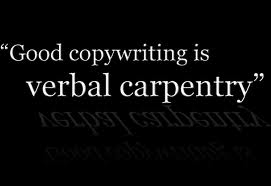What? You Mean I Have to Write the Copy Too?
 So you’ve got a great widget and you want to tell the world about it. You decide you’re going to get a brochure printed. You’re going to get some ads out, write a press release and put a fabulous website up. Then it dawns on you. “Oh, I have to write something up for these ads and for the brochure, and I’ll have to say something on my website pages.” You wonder if you should do this yourself or hire someone. Copywriting? Piece of cake. You should be able to throw something together in an hour or so. Copywriting is easy, right? You just sit down at a computer and bang out some glowing words about your (or your client’s) product.
So you’ve got a great widget and you want to tell the world about it. You decide you’re going to get a brochure printed. You’re going to get some ads out, write a press release and put a fabulous website up. Then it dawns on you. “Oh, I have to write something up for these ads and for the brochure, and I’ll have to say something on my website pages.” You wonder if you should do this yourself or hire someone. Copywriting? Piece of cake. You should be able to throw something together in an hour or so. Copywriting is easy, right? You just sit down at a computer and bang out some glowing words about your (or your client’s) product.
Not so fast.
There is a lot more that goes into really good copywriting – the kind that makes people actually want to buy what you are selling. And much of it is done before you write your first word. Here are some of the things that make good copywriting good:
1. What are you selling?
“That’s easy,” you might think, “I’m selling widgets.”
But let’s get specific. Is your product a high-end widget, “for the discerning consumer”? Or is it the low-end widget, for those who are looking for a bargain? Does it come with a warranty? Do you offer widget service and repair? Do you offer different sizes? Do you have children’s widgets?
There are many dimensions to a product. How is it made? What ingredients go into it? How does it work? What does it do? Can you get a sample? Can you try it? Are their legal points that must be kept in mind? Disclaimers? Claims that must be avoided?
A good copywriter will get very familiar with the product in all its aspects.
2. Who are you selling to?
Again, you might say “That’s an easy one – I’m selling to people who need widgets.”
Okay, but who are they, exactly? Are they young or old, men or women? Are they college educated or not? Do they tend to live in rural or urban areas? Are they affluent or not?
Even business customers have a profile. Let’s say you sell your widgets to hardware stores. Fair enough, but are you likely to sell more to big chain hardware stores or little independent shops? Are you likely to sell more in the Midwest or on the West Coast?
How do you find this out? Talk to your sales people and ask them to describe their best prospects. Go through old accounts and see who has bought your product in the past. If you are writing for a client, talk to them and ask them about their customers.
3. Why do people buy it?
What benefit do people get from your widget? Does it save them money? Does it save time? Does it make their life easier?
Remember, good copywriting talks about benefits, not about features. Don’t talk about “dual core processors,” talk about how “you’ll save time with fewer annoying wait periods.”
Talk to customers. Go onto forums that talk about this kind of product. Read customer letters, testimonials, and blog comments. Read complaint letters. What are people saying? What do they like? What don’t they like?
Read what your customers read – magazines, websites. What are their interests? What words and terms do they use?
Were there any successful campaigns run in the past? Look at successful promotion or campaigns and see what was offered.
What are the reasons why a consumer would not buy your product? What are objections you might have to overcome?
4. What’s the competition?
Who else is selling widgets? How do they sell them? What benefits are they offering? What does their website look like? Who are their customers? What do their customers like? What do their customers dislike?
You can learn a lot by studying the literature, websites and blogs of those in a similar business. The web contains a wealth of information about competitors.
 How does your product compare to the competition? Is it better quality? Cheaper? Old-time copywriters talked about the “Unique Selling Proposition” (USP). What do you offer that your competitors don’t? What makes your product or services different or unique. As the saying goes “never write an ad that your competitor could sign.”
How does your product compare to the competition? Is it better quality? Cheaper? Old-time copywriters talked about the “Unique Selling Proposition” (USP). What do you offer that your competitors don’t? What makes your product or services different or unique. As the saying goes “never write an ad that your competitor could sign.”
5. What should the copy accomplish?
This is key. What is the purpose of the copy? Is it direct sales or list-building? Are you trying to get people to go to a retail store? Are you trying to get people to call a toll-free number? What will the “call to action” be?
6. Now, write the copy
With all of the above firmly in mind, you should now be able to write copy that is authoritative, compelling and interesting. You should know exactly how to talk to the potential customer – the words, the concepts, the tone of voice.
There is much that goes into a good piece of copy – a compelling headline, benefit-driven “you” copy that speaks to the needs and desires of the customer, use of numbered lists and bullets to focus on key selling points, memorable stories and examples, and a clear and concise call-to-action.
A good copywriter writes and rewrites, taking care that every word, phrase and transition is doing its job to the utmost.
So you’ve finished your copy. It’s brilliant, and you’re sure it will generate tons of clicks or calls or traffic. Time to publish? Again, not so fast.
7. Review, review, review
Take a break, then come back and read it again. Correct the things you missed.
Have a friend or co-worker or salesman or client read the copy. What are their impressions? What suggestions do they have for improvement?
Read it out loud. Does it sound natural and conversational, or does some of the wording make you cringe? Does it flow well or does it sound forced?
Polish that copy up to a high gloss.
8. Those pesky search engines
And before you finish, make sure you’ve covered those all-important search terms. Is there a reason to write your copy first – then check for search terms? Yes – you don’t want to write copy around search terms. That can result in copy that is artificial and contrived. Write your brilliant copy first, then check that you’ve covered all your search basics.
There is much to know about SEO keywords, far more than can be covered here. You can find key words for your type of business by using online tools such as Google Adwords Keyword Estimator.
The bottom line is, try to include the most obvious words a potential customer would use to search for what you are offering, such as “widget supplier in Bend, Oregon,” or “Mexican Restaurant in Southeast Portland.” But don’t load in excess keywords to the detriment of good, clear, compelling sales copy.
 You can see there is a lot more to writing good copy than just sitting down at your computer and dashing out some glowing words.. Good copy is 90% preparation and research. And when you’ve done your homework, the writing itself flows quickly. You have certainty on what you are selling, who you are talking to, and what benefits they are looking for. You know how to make your copy unique and impinging.
You can see there is a lot more to writing good copy than just sitting down at your computer and dashing out some glowing words.. Good copy is 90% preparation and research. And when you’ve done your homework, the writing itself flows quickly. You have certainty on what you are selling, who you are talking to, and what benefits they are looking for. You know how to make your copy unique and impinging.
And if you do decide to hire a professional copywriter, no doubt you realize after reading the above, that any pro copywriter puts a lot more into writing those few paragraphs for your brochure than just sitting down and banging out some text. Something to keep in mind when shopping for a writer!
What have your experiences been when trying to write copy?
Read our article on how to write a business description.







